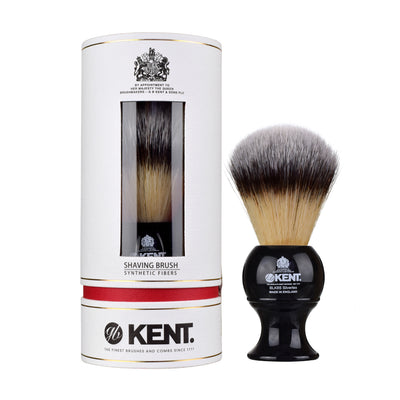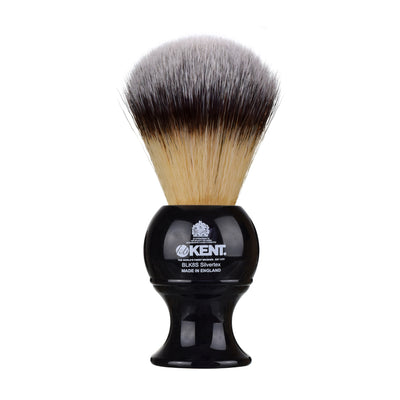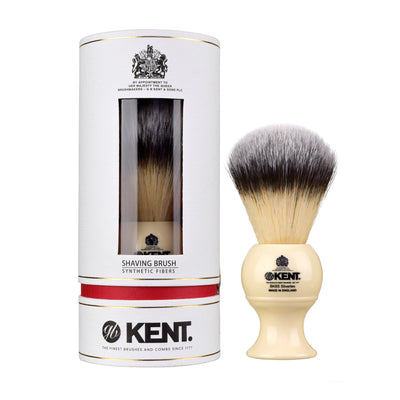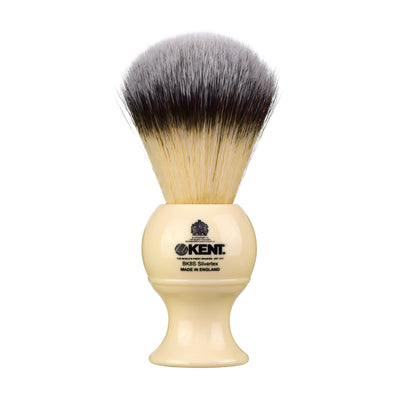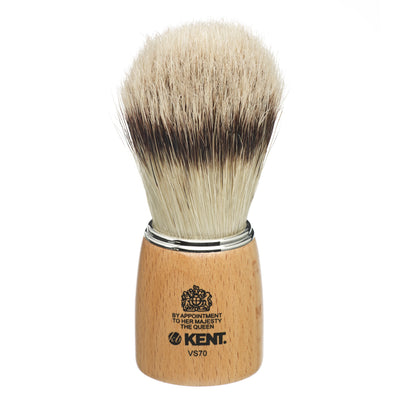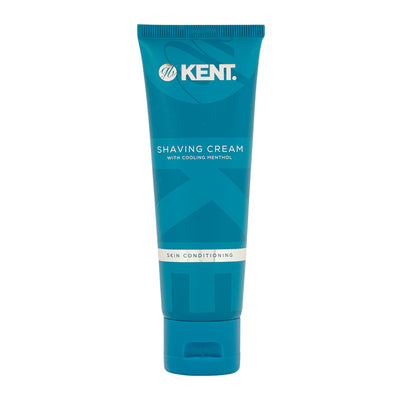Choosing the right shaving brush is key to achieving a close, smooth shave. And as they come in a variety of different bristle types, sizes and materials, we’ve put together the Kent guide to choosing the best shaving brush for you. After all, a good-quality shaving brush is an essential part of every man’s grooming kit.
WHY USE A SHAVING BRUSH?
Why use a shaving brush when you can just pat some shaving foam on to your face with your hands? The quick answer is, without using a shaving brush you won’t be able to achieve so close a shave.
Shaving brushes are much more effective and kinder to the skin for a variety of reasons:
- They’re designed to soften and gently raise the hair away from your face, allowing you to achieve a closer shave.
- A good-quality shaving brush is more efficient, meaning you need to use less shaving cream or soap for each shave. It creates a rich lather by whipping air into the shaving soap.
- In doing so, it’ll also add heat to the surface of your skin, helping to open and cleanse pores.
- Your brush will also gently exfoliate the surface of your skin, removing dead skin cells that can block pores and cause blemishes.
And of course, if you want to use good-quality shaving soaps, a shaving brush is indispensable.
HOW TO CHOOSE THE BEST SHAVING BRUSH
There are so many options to choose from when it comes to choosing a shaving brush. It can be hard to know which are the best and what to avoid. Let’s take a glance at some of the things you need to look out for when it comes to shopping for your brush.

Firstly, it pays to know the lingo - when you’re choosing a shaving brush, you'll come across several terms used to refer to various parts of the brush. It’s easier to know what you’re buying if you understand exactly what these terms mean.
BRISTLE - Bristles are the hair or fibres from which the brush is made. Different types of bristles have different qualities.
BASE - At the opposite end of the brush to the bristles, the base of a shaving brush is often squared off so that it can stand upright, or tapered so that it can be held up-side down in a shaving brush stand.
LOFT - Loft is a term used to describe the length of the bristles. It refers to the length of the bristle hairs from the top of the handle to the tips of the bristles. 55mm is the average loft for most shaving brushes.
HEIGHT - This refers to the entire length of the shaving brush, including the length of the handle and the length of the loft.
KNOT - The knot is where the bristles are brought together and glued into the base of the handle.
BACKBONE - We use this term to describe the stiffness of a brush’s knot. As the density of the bristles increases, so the backbone of the brush increases. Shaving brushes with more backbone feel stiffer and are great for exfoliating the skin.
SCRUB - The scrub of a brush is determined by the stiffness of the bristles against your skin. A brush with a stiff backbone and tight knot will have a strong scrub and exfoliate the skin effectively. Softer brushes with a smaller knot are more gentle on the skin.
SHAVING BRUSH BRISTLES
Traditionally shaving brushes have usually been made from badger hair. These days there are a wider variety of bristles to choose from, both natural and synthetic. Most shaving brushes are made from the hair of boars, horses and badgers, or from synthetic fibres.
SYNTHETIC SHAVING BRUSH
Good-quality shaving brushes made from synthetic bristles have all the benefits of brushes made using traditional materials with some additional qualities. Their crimped fibres emulate pure bristle and help to retain water to generate a good lather. They’re soft on the face but strong enough to lift hairs away from the face to allow a close shave. High-quality synthetic bristles are on a par with the badger bristles, but beware low-quality cheap brushes made from thick nylon bristles - they are likely to irritate the skin.
Synthetic bristles are very durable and resistant to mildew, making them long-lasting and easy to maintain. For this reason, they’re a popular choice for men with busy lifestyles or those looking to buy a travel shaving brush. They’re also PETA-approved, vegan and ideal for those who are allergic to animal hair.
BOAR HAIR SHAVING BRUSH
Boar hair bristles provide a deep scrub - they do a good job of exfoliating dead skin and lifting the hair away from the face, both essential for a close shave. The coarsensess of boar hair brushes can feel uncomfortable on the skin at first, but over time the stiffness of these bristles become softer as they begin to split with regular use. However, boar bristles will never feel as soft on the face as badger or synthetic bristles. If you’re looking for a decent shave on a tight budget, boar bristles will do the job.
HORSE HAIR SHAVING BRUSH
Horse hair shaving brushes aren’t so commonplace in the UK, but seem to be favoured more on the continent. They’re softer than boar hair bristles, but not so soft as badger or synthetic bristles.
BADGER HAIR SHAVING BRUSH
Badger hair has traditionally been used to make shaving brushes because they are soft on the skin whilst maintaining good water retention and generate a good lather. They’re much softer than both boar and horse hair bristles. Although require more regular maintenance than synthetic shaving brushes.
OTHER ELEMENTS OF A SHAVING BRUSH TO CONSIDER
The type of bristle you choose is the main determining factor in the quality of your shaving brush. However, you may want to also consider the following factors when choosing the right shaving brush for you:
SHAVING BRUSH HANDLES
Shaving brush handles that have been well designed will fit comfortably in your hand, feel balanced and provide a solid grip.
KNOT SIZE AND LOFT HEIGHT
Knot size and loft height come down to a matter of personal preference. The larger the knot, the more water the brush retains and the firmer it feels against the skin. Similarly, brushes with a higher loft will retain more water, making it easier to lather up larger areas.
WATER RETENTION
Good water retention is an important element of a decent shaving brush as it allows you to build a richer, more thorough lather. Poor water retention means the bristles won’t be able to generate and hold a lather, making it difficult to apply. All Kent shaving brushes have been designed to offer good water retention.

SHEDDING
Every new shaving brush will shed a few hairs to begin with. This is part of the brush-making process and is to do with those few hairs that have not reached the glue in the knot of the brush. Good-quality brushes will cease to shed after the first few shaves. Lower-quality brushes will continue to shed even after months of use. At Kent, we hand-make each of our shaving brushes to the highest standard, maintaining the same quality for more than 200 years.
NEED MORE ADVISE?
For more advice about how to choose the right shaving brush, contact us - we’d love to help. And for shaving tips and advice, check out our blog post on how to wet shave.




